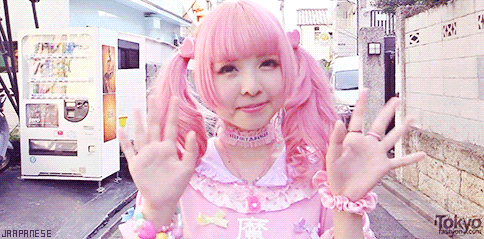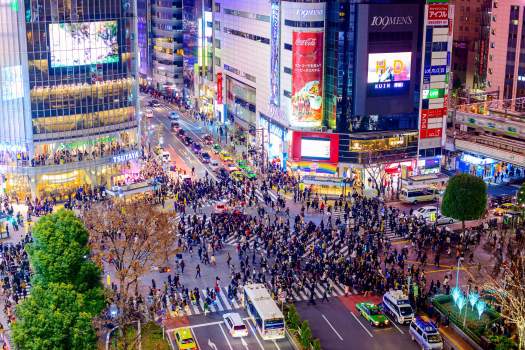Tokyo is not only the capital of Japan but it is also the Japanese capital of fashion and potentially one of the trend-setting capitals of the world.
Fashion shows move off the cat walk and onto the streets of the cities district’s. Showcasing bright, expressive and culturally impacting styles that are fascinating to all that observe it. Two of the major districts in Tokyo for fashion are Shibuya and Harajuku. They are filled with fashion conscious shoppers daily, each expressing their style that matches the district they are in.
Shibuya:
Shibuya is the most active shopping district in all of Tokyo. It is the home of department stores and attracts a large audience of pre teens and teens. It is known for three of the most popular shopping streets in Tokyo: Spain Zaka, Koen Dori and Center Gai. Center Gai is the hub for the fashion subculture of Gyaru. People who identify as Gyaru go for a fashion glam look, usually sporting beach style hair and tans.
Shibuya attracts a lot of young people that are still trying to find their styles or are more interested in a glam-based look. Many of the styles that Shibuya cater to are very similar to Western clothing, with trends constantly changing.
Shibuya is known for its iconic shopping centre Shibuya 109 or “ichi maru kyu”. In the video I have linked below by a YouTuber called “Ines Japan” you will be able to see how large Shibuya 109 is and the many different styles it caters to.
From this video you can see how versatile the shopping options are in Shibuya, but it is still mainly targeted to a younger audience, where older shoppers usually like to avoid.

Harajuku:
Harajuku is internationally known for its young, energetic and extreme fashion choices. This district attracts crowds of youths from ages 13 – early 20’s, each expressing their own individual interpretation of the fashion subculture that they wish to portray. Harajuku has made its way into many Western main-stream music, inspiring artists such as Katy Perry, Nicki Minaj and (most famously) Gwen Stefani.
Harajuku’s streets are lined with inexpensive stores that are home to Kawaii (cute) clothing, Lolita fashion options as well as a multitude of other flamboyant options for their shoppers. In the back streets of Harajuku shoppers can find vintage clothing stalls packed with accessories and other items, this can range from older victorian clothing items (Gothic Lolita) to 80’s inspired items.
Many international fashion designers keep an eye on the Harajuku district, as it is the source for a lot of trends that can sometimes be seen entering the international fashion market.
Both Shibuya and Harajuku are fashion forward districts in Tokyo city. Each allowing the population to buy clothing and to have a space to express themselves through the outfits that they were. If you are looking for a more modern, Western feeling to shopping Shibuya is definitely the district for you, but if you are interested in the many styles and fashion expressions of Japan, you should go to Harajuku.
Don’t forget to leave me a comment if you have any questions about this topic, I would love to give you some more information if you need it. Next post will be about the culture of Kawaii and how it has influence over Japan. Thanks for coming 🙂



Great read, thanks for posting. I’m interested to know what (if any) influence traditional Japanese costume/textile techniques (shibori, silk embroidery, metal applique, paste resist etc) has in Shibuya and Harajuku?
LikeLiked by 1 person
From what I can find textile tradition is very clear in Lolita (specifically Gothic Lolita) styling. A lot of it is kimono based work and old victorian and edwardian styles. It might be interesting to do further research into this, but on the surface that is what I can mainly find it in 🙂
thank you for your question and for commenting on my post!
LikeLike
How would you say the style in Japan has influenced western culture and style?
LikeLiked by 1 person
With musical artists and public figures (like the examples I gave) have brought forward and impacting movement of Western cultures enjoying similar styles to that of the Harajuku district.
Gwen Stefani got a lot of criticism about it after her song “Harajuku girls”.
Cosplay has also become very popular with expos like comic con all over the media, people get inspired by this subculture of fashion. Cosplay can be tracked back to Japanese comics and also is very very popular in districts like Harajuku.
Finally you can see Kimonos (Lolita subculture) in fashion shows across the globe. With young fashion designers like Saito have been sending their models down runways sporting Kimono’s at events like Tokyo’s fashion week etc. A-list celebrities e.g. Kim Kardashian have been spotted wearing Kimonos due to Japanese influence over the west.
Thanks for commenting 🙂
LikeLike
Awesome insight into fashion in Tokyo 👍🏻
LikeLiked by 1 person
Very interesting!
LikeLiked by 1 person
Noah is there a male version of Harajuku fashion ? Or do they have a different style of their own ? I know males in Japan are just as interested in appearance so i am curious if their style has a name
LikeLiked by 1 person
Yes male fashion is HUGE in Japan, in fact I am planning to do a post dedicated to that exact topic in the middle of next week. In that post I will be discussing the importance of men in the Japanese fashion world as well as the subcultures of male fashion. In the Shibuya district there is a male equivalent of Gyaru named Gyaruo. It has sub types of biker fashion, army fashion, including many others. When discussing the Harajuku district, a lot of males find the Kawaii (cute) style appealing and cosplay is very evenly distributed across both males and females. I hope you stay tuned for that post and continue to comment. 🙂
LikeLike
Thank you i should have guessed you were on to it and would enlighten us in weeks to come . Let me know when you do your next post i dont use my word press anymore
LikeLiked by 1 person
How much of this fashion is connected / inspired by Anime?
LikeLiked by 1 person
Funny i was thinking thatvtoo, i also wondered which came first the fashions or anime art , i am a big fan of anime art but i dont know much about its origins
LikeLike